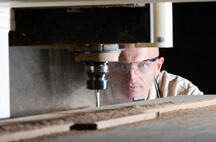

April 28, 2009
A bit of advice: cooling can lengthen tool life, Purdue expert says
WEST LAFAYETTE, Ind. - |
Rado Gazo, a Purdue University professor of wood processing and industrial engineering, found that cryogenically treating router bits, as well as cooling them while they cut, can increase the tools' lives - in some cases doubling them. His findings were posted in the early online edition of the Journal of Materials Processing Technology.
"Excessive heat is a major contributor to premature tool wear," Gazo said. "In metal machining, you put water on the tools to keep them cool, but you can't do that when cutting wood."
The tungsten-carbide router bits that Gazo tested use cobalt as a glue to hold the tungsten-carbide molecules together. Friction heats the bits as they make cuts, causing a chemical reaction that results in the loss of some cobalt.
"At high temperatures, the cobalt melts and evaporates," Gazo said. "As that glue vaporizes, the tungsten-carbide particles simply fall off."
Gazo was able to show that either cryogenically treating the bits to harden them, blowing cooled air on them during use, or doing both, improved the life of tools and kept cuts clean later in the tools' lives. Cryogenic treating requires cooling the tools to -300 degrees Fahrenheit and then bringing them back up to ambient temperature, a process that can cost just a few dollars per pound of tools.
Gazo used a router bit that had not been cryogenically frozen or exposed to cool air during use as a control and cut more than 100 miles of tool path in a medium-density fiberboard. Bits that were not frozen but subjected to a blast of 40-degree and 20-degree Fahrenheit air during use increased tool life by as much as 25 percent.
A bit that had been cryogenically frozen but not cooled during use increased tool life by about 65 percent over the control. Blowing 40-degree air on that bit increased its life 85 percent, and using 20-degree air increased tool life by 217 percent. Bits with less wear, and thus longer lives, also gave cleaner cuts for a longer period into the tests. The tools also consumed less power and created less noise during cutting
Gazo said manufacturers would likely find cryogenic treating an affordable option for increasing tool life in tungsten-carbide tools. Applying cooled air, however, would be best evaluated on a case-by-case basis.
"You've got to figure out the safety and whether it is worth the trouble of setting up," Gazo said. "This is worth investing for a company that wants to save money on tools. There is a benefit to be had."
The Purdue Center for Advanced Manufacturing provided funding for Gazo's research. Vortex Tool Co. and EXAIR provided materials.
Gazo said the next step in his research would be to test other tool treatments.
Writer: Brian Wallheimer, (765) 496-2050, bwallhei@purdue.edu
Source: Rado Gazo, (765) 494-3634, gazo@purdue.edu
Ag Communications: (765) 494-8415;
Steve Leer, sleer@purdue.edu
Agriculture News Page
PHOTO CAPTION:
Rado Gazo inspects a router as it makes cuts in a sheet of medium-density fiberboard. Gazo found that cryogenically treating and then cooling router bits as they make cuts could extend the lives of the tools. (Purdue Agricultural Communications photo/Tom Campbell)
A publication-quality photo is available at https://www.purdue.edu/uns/images/+2009/gazo-router.jpg
Effects of Cryogenic Treatment and Refrigerated Air
on Tool Wear When Machining
Medium Density Fiberboard
Judith Gissip, Rado Gazo, Harold A. Stewart
Cooling of cutting tools with liquid coolants and lubricants is impractical when machining dry wood or wood composites. This study examines the combined effect of cryogenic tool treatment and using refrigerated air for cooling tools on reducing tool wear. A total of four, double-flute, solid, tungsten carbide router bits were used to machine medium density �?berboard with a CNC router. Three of the four tools were cryogenically treated to below −149◦C. During cutting, refrigerated air was applied to two tools, while the other two cut at ambient temperature. All tools were examined under the stereo light microscope to capture images in order to measure tool wear. Elemental analysis was performed using scanning electron microscopy to determine the percentage of speci�?c elements present on clearance faces of tools after cutting was completed. Results show that less tool wear occurs when using refrigerated air and cryogenic treatment, thereby increasing tool life when cutting medium density �?berboard.
To the News Service home page
